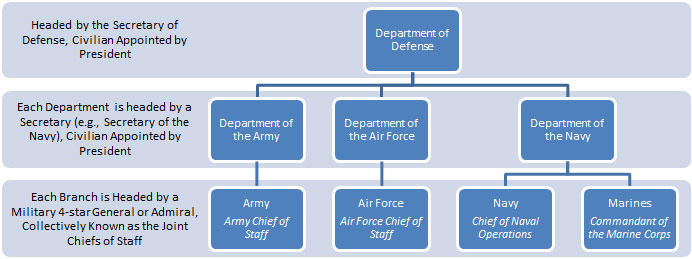Attention A T users. To access the menus on this page please perform the following steps.
1. Please switch auto forms mode to off.
2. Hit enter to expand a main menu option (Health, Benefits, etc).
3. To enter and activate the submenu links, hit the down arrow.
You will now be able to tab or arrow up or down through the submenu options to access/activate the submenu links.
Locator
Contact
Search
Structure and Branches
The US military has five branches: the Army, Navy, Air Force, Marines, and Coast Guard. As shown in the graphic below, the Army, Navy, Air Force, and Marines are housed under the Department of Defense (DOD). The DOD is headed by The Secretary of Defense, a civilian appointed by the President. Each department within the DOD is headed by its respective Secretary (e.g., the Secretary of the Army), civilians appointed by the President. Each branch is headed by a military 4-star general or admiral (i.e., Army Chief of Staff, Air Force Chief of Staff, Chief of Naval Operations, and Commandant of the Marine Corps) and these individuals are collectively known as the Joint Chiefs of Staff.
The Coast Guard is housed under the Department of Homeland Security during peacetime and can serve as part of the Navy's force during times of war. Each branch of the military has a Reserve component. In addition, our nation is also served by the National Guard and the Merchant Marine (described in the Active Duty vs. Reserve or National Guard handout).

Text alternative for the diagram above.
Here are some brief descriptions of the branches.
Army
The Army defends the land mass of the U.S., its territories, commonwealths, and possessions. It does so through providing forces and capabilities for sustained combat and stability operations on land. The Army also provides logistics and support to other branches. The Army is the largest and oldest branch of the military.
Navy
The Navy maintains, trains, and equips combat-ready maritime forces capable of winning wars, deterring aggression, and maintaining freedom of the seas. The Navy is America's forward deployed force and is a major deterrent to aggression around the world.
Air Force
The Air Force provides a rapid, flexible, and when necessary, lethal air and space capability that can deliver forces anywhere in the world in less than forty-eight hours. It routinely participates in peacekeeping, humanitarian, and aeromedical evacuation missions. Air Force crews annually fly missions into all but five nations of the world.
Marine Corps
The Marine Corps maintains ready expeditionary forces, sea-based and integrated air-ground units for contingency and combat operations, and the means to stabilize or contain international disturbance. The Marine Corps is an immediate response force that can be used to overwhelm the enemy.
Coast Guard
The Coast Guard provides law and maritime safety enforcement, marine and environmental protection, and military naval support. Activities can include patrolling our shores, performing emergency rescue operations, containing and cleaning up oil spills, and keeping illegal drugs from entering American communities.































